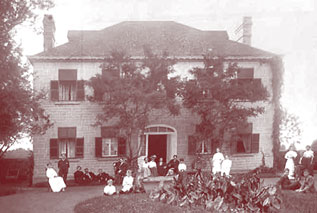 |
Water, Water Everywhere
The Ottawa River from the Deschênes Rapids
to the Chaudières Rapids is a combination
of slow- and fast-moving water. The rock you are
standing on was formed by the lithification of sediment
deposited in a warm tropical ocean that once covered
this area 450 million years ago. Look closely, and
in a few places you can see rounded domes in the
rock called stromatolites — the algae and
bacteria that built these domes are believed to
have produced the Earth’s oxygen. The topography
of this section of the river appears much the same
today as it has since the retreat of the Champlain
Sea after the last ice age, just 8,000 years ago.
Most of the pine that used to grow along the banks
has been replaced by young mixed woods consisting
of red and bur oak, basswood, elm, white and black
ash, silver maple, willow and poplar. Over 200 species
of birds can be seen annually, ranging from waterfowl
and shore birds to songbirds. At least 15 species
of fish exist in this section of the river, and
in recent years several thousand brown trout have
been stocked annually. |
| |
|
|
 |
Life at the Rapids
The First Nations people once lived, hunted and
fished along the banks of the Ottawa River. Archaeological
evidence establishes their presence in the valley
approximately three to four thousand years ago.
European settlers and fur traders settled here,
too. It is still possible to walk in the voyageurs’
footsteps on their old portage path at Brebeuf Park
on the Quebec shore of the Lemieux Rapids.
The first lumber mill on the Ottawa River was built
by Philemon Wright circa 1800. Approximately 120
metres east of this kiosk, the ruins of the first
steam-driven mill, erected in the 1870s, are still
visible. Today, the river still sustains the people
living in the region. Over a million people get
their drinking water from three filtration plants
located along the river. It has also become significant
for its many recreational opportunities.
The National Capital Commission maintains parkland
and pathways in the region that allow residents
and visitors to enjoy walking, cycling, swimming,
paddling, fly-fishing and bird watching. |
| |
|
